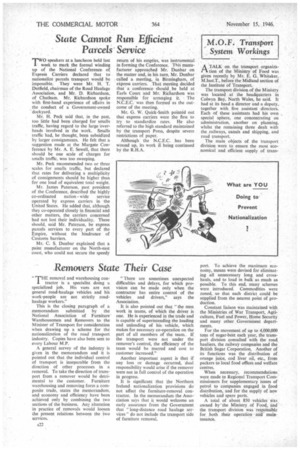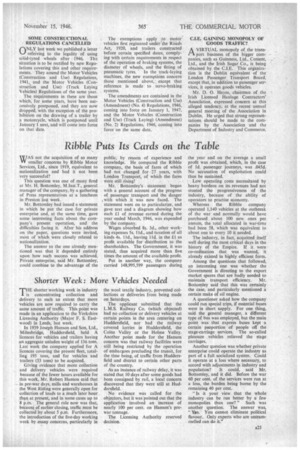Removers State Their Case
Page 24

Page 25

If you've noticed an error in this article please click here to report it so we can fix it.
" THE removal and warehousing contractor is a specialist doing a specialized jab. His vans are not general road-haulage vehicles and his work-people are not strictly roadhaulage workers."
This is the closing paragraph of a memorandum submitted by the National Association of Furniture Warehousemen and Removers to the Minister of Transport for consideration when drawing up a scheme for the nationalization of the road transport industry. Copies have also been sent to every Labour M.P.
A general survey of the industry is given in the memorandum and it is pointed out that the individual control of transport is inseparable from the direction of other processes in a removal. To take the direction of transport from a remover would be detrimental to the customer. Furniture warehousing and removing form a composite trade, states the memorandum, and economy and efficiency have been achieved only by combining the two sections of the business. Any alteration in practice of removals would loosen the present relations between the two services.
"There are sometimes unexpected difficulties and delays, for which provision can be made only when the contractor has entire control of the vehicles and drivers," says the Association.
It is also pointed out that "the men work in teams, of which the driver is one. He is experienced in the trade and is capable of superintending the loading and unloading of his vehicle, which makes for necessary co-operation on the part of all members of the team. If the transport were not under the remover's control, the efficiency of the team would be marred and cost to customer increased."
Another important aspect is that if any loss or damage occurred, dual responsibility would arise if the remover were not in full control of the operation in progress.
It is significant that the Northern Ireland nationalization provisions do not affect the furniture-removal contractor. In the memorandum the Association says that it would welcome an early assurance from the Government that "long-distance road haulage services" do not include the transport side of furniture removal.
port. To achieve the maximum economy, means were devised for eliminat ing all unnecessary long and cross hauls, and to load in bulk as much as possible. To this end, many schemes were introduced. Commodities were zoned, so that each district could be supplied from the nearest point of production.
Constant liaison was maintained with the Ministries of War Transport, Agri
culture, Fuel and Power, Home Security and many other .Government departments.
For the movement of up to 4,000,000 tons of sugar-beet each year, the trans
port division consulted with the road.
hauliers, the railway companies and the British Sugar Corporation. Another of
its functions was the distribution of orange juice, cod liver oil, etc., from packers to local food offices and welfare Centres.
When necessary, recommendations were made to Regional Transport Com
missioners for supplementary issues of petrol to companies engaged in food distribution, and for the supply of new vehicles and spare parts.
A total of about 850 vehicles was owned by'the Ministry of Food, and the transport division was responsible for both their operation and maintenance. SOME CONSTRUCTIONAL REGULATIONS CANCELLED
ONLY last week we published a letter referring to the legality of using solid-tyred wheels after 1946. The situation is to be rectified by new Regulations covering this and other requirements. They amend the Motor Vehicles (Construction and Use) Regulations, 1941, and the Motor Vehicles (Construction and Use) (Track Laying Vehicles) Regulations of the same year.
The requirements in these are those which, for some years, have been successively postponed, and they are now dropped, with the exception of the prohibition on the drawing of a trailer by a motorcycle, which is postponed until January 1 next, and will come into force on that date. The exemptions apply to motor vehicles first registered under the Roads Act, 1920, and trailers constructed before certain specified dates, complying with certain requirements in respect of the operation of braking systems, the diameter of wheels, and the fitting of pneumatic tyres. In the track-laying machines, the new exemptions concern those mentioned above, except that reference is made to servo-braking systems.
The amendments are contained in the Motor Vehicles (Construction and Use) (Amendment) (No. 4) Regulations, 1946, coming into force on January 1, 1947, and the Motor Vehicles (Construction and Use) (Track Laying) (Amendment) (No. 2) Regulations, 1946, coming into force on the same date.




































































